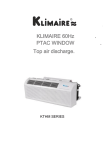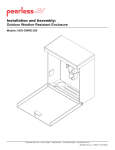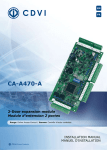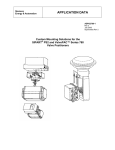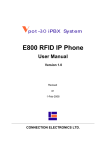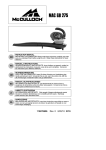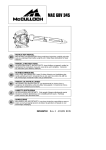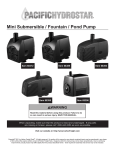Download Weed Eater DAHT 22 Instruction manual
Transcript
GB ES FR PT INSTRUCTION MANUAL IMPORTANT INFORMATION: Please read these instructions carefully and make sure you understand them before using this unit. Retain these instructions for future reference. MANUAL DE INSTRUCCIONES INFORMACIÓN IMPORTANTE: Lea atentamente las instrucciones y asegúrese de entenderlas antes de utilizar esta aparato. Conserve las instrucciones para la referencia en el futuro. MANUEL D’INSTRUCTIONS RENSEIGNEMENTS IMPORTANTS: Avant d’utiliser cet appareil, veuillez lire atentivement les instructions et assurez--vous de les avoir comprises. Conservez les instructions pour référence ultérieure. MANUAL DO OPERADOR INFORMAÇÕES IMPORTANTES: Favor ler estas instruções com cautela e certifique--se de que tem completo entendimento antes de usar o ferramenta e guarde para consulta futura. 115145929 Rev. 2 2/18/09 BRW IDENTIFICATION (WHAT IS WHAT?) 15 12 13 14 1 4 3 6 2 8 10 16 9 5 1. 2. 3. 4. 5. 6. 7. 8. Cutter blades Hand guard Spark plug Starter rope handle Air filter Primer bulb Choke lever ON/OFF Switch 9. 10. 11. 12. 13. 14. 15. 16. 11 Throttle trigger Throttle lock--out Fuel cap Transport guard Blunt extension Front handle Rear handle Instruction Manual IDENTIFICATION OF SYMBOLS WARNING: WARNING: This hedge trimmer can be dangerous! Careless or improper use can cause serious or even fatal injury. Cutting blade can throw objects violently. --- You can be blinded or injured. --- Always wear eye protection. WARNING: Blade moves momentarily after trigger is released. ---The cutting blade can seriously cut you or others and can amputate fingers. ---Allow cutting blade to stop before removing it from the cut. ON OFF Always use: --- Ear protection --- Protective glasses or visor Read and understand the Instruction Manual and all warning labels before using the hedge trimmer. Sound power level Checks and/or maintenance should be carried out with the engine switched off, with the ON/OFF switch in the OFF position. Sound pressure level at 7,5 meters -- 2 -- 7 SAFETY RULES DANGER - THIS POWER TOOL CAN BE DANGEROUS! This unit can cause serious injury including amputation or blindness to the operator and others. The warnings and safety instructions in this manual must be followed to provide reasonable safety and efficiency in using this unit. HAZARD ZONE The operator is responsible for following the warnings and instructions in this manual and on the unit. Never allow children to use this tool. WARNING: Failure to follow all Safety Rules and Precautions can result in serious injury. WARNING: Hazard Zone D Blades can throw objects violently. D Others can be blinded or injured. D Keep children, bystanders, and animals away from work area a minimum of 10 meters when starting or operating unit. 10 m KNOW YOUR UNIT S Read your Instruction Manual carefully until you completely understand and can follow all warnings and safety rules before operating the unit. D Restrict unit to users who understand and will follow all warnings and safety rules in this manual and on the unit. HANDLE FUEL WITH CAUTION, IT IS HIGHLY FLAMMABLE D D PLAN AHEAD D D D Safety Glasses WARNING: Boots Inspect the area before starting the unit. Remove all debris and hard objects such as rocks, glass, wire, etc. that can ricochet, be thrown, or otherwise cause injury or damage during operation. D Always wear eye protection when operating, servicing, or performing maintenance on unit. Wearing eye protection will help to prevent rocks, brush or debris from being thrown or ricocheting into eyes and face which can result in blindness and/or serious injury. Eye protection should be marked Z87. D Always wear foot protection. Do not go barefoot or wear sandals. D Wear hearing protection when using this unit. D Secure hair above shoulder length. Secure or remove jewelry, loose clothing, or clothing with loosely hanging straps, ties, tassels, etc. They can be caught in moving parts. D Do not operate unit when you are tired, ill, upset, or if you are under the influence of alcohol, drugs, or medication. D Keep children, bystanders, and animals away from work area a minimum of 30 feet (10 m) when starting or operating unit. D D D Eliminate all sources of sparks or flame (including smoking, open flames, or work that can cause sparks) in the areas where fuel is mixed, poured, or stored. Mix and pour fuel in an outdoor area; store fuel in a cool, dry, well ventilated place; use an approved, marked container for all fuel purposes. Do not smoke while handling fuel or while operating the unit. Do not fill fuel tank while engine is running. Turn the engine off and let hedge trimmer cool in a non--combustible area, not on dry leaves, straw, paper, etc. Slowly remove fuel cap and refuel unit. Wipe up fuel spills before starting the engine. Move at least 10 feet (3 meters) away from fuel and fueling site before starting engine. Always store gasoline in a container approved for flammable liquids. OPERATE YOUR UNIT SAFELY DANGER: RISK OF CUT; KEEP HANDS AWAY FROM BLADE! Blade moves momentarily after the trigger is released. Do not attempt to clear away cut material when the blade is in motion. Make sure the switch is in the OFF position, the spark plug wire is disconnected, and the blade has stopped moving before removing jammed material from the cutting blade. Do not grab or hold the unit by the cutting blade. D Inspect unit before each use for worn, loose, missing, or damaged parts. Do not use until unit is in proper working order. D Keep outside surfaces free from oil and fuel. D Never start or run engine inside a closed room or building. Breathing exhaust fumes can kill. D Avoid dangerous environments. Do not use in unventilated areas or where explosive vapors or carbon monoxide build up could be present. -- 3 -- D D D D D Do not overreach or use from unstable surfaces such as ladders, trees, steep slopes, rooftops, etc. Keep firm footing and balance at all times. Do not raise unit above your shoulders; the cutting blade can come dangerously close to your body. Always keep unit in front of your body. Keep all parts of your body away from the cutting blade. Keep the cutting blade and air vents free from debris. Use only for jobs explained in this manual. D D D D SAFETY EQUIPMENT NOTE: This section describes the hedge- trimmer’s safety equipment, its function and how checks and maintenance are carried out to ensure that it operates correctly (see WHAT IS WHAT? to locate where this equipment is positioned on your machine). WARNING: Never use a machine with damaged or inoperative safety equipment. Follow the control, maintenance and service instructions described in this section. D ON/OFF switch -- The ON/OFF switch should be used to stop the engine. D Throttle lock-- out -- The throttle lock--out must be pressed before squeezing the throttle trigger. This feature prevents accidental squeezing of the throttle trigger. D Blunt entension -- The blunt extensions of the cutting blade are designed to prevent contact with the blade. D Hand guard -- The guard is intended to prevent objects from being thrown towards the operator. D Transport guard -- The transport guard is designed to cover the cutting blades during transport and storage. D Silencer - The silencer is designed to give the lowest possible noise level and to direct the engine’s exhaust fumes away from the operator. The engine’s exhaust fumes are hot and can contain sparks which can lead to the outbreak of fire. WARNING: During use and for some time after, the silencer is very hot. Do not touch the silencer if it is hot. A hot silencer can cause serious burns. D Cutting equipment -- The trimmer is intended for trimming hedges. CONTROL, MAINTENANCE AND SERVICE OF THE SAFETY EQUIPMENT D D WARNING: Never use a machine with damaged or inoperative safety equipment. The safety equipment should be maintained as described in this section. If your machine does not meet any of these controls, you should contact your authorised service dealer. MAINTAIN YOUR UNIT PROPERLY D D D D D D WARNING: All service and repairs to the hedgetrimmer require special training. This applies especially to the safety equipment. If the hedgetrimmer does not meet any of the controls listed below, you should contact your authorised service dealer. D ON/OFF switch -- Start the engine and make sure that the engine stops when the ON/OFF switch is moved to the OFF position. Throttle lock-- out -- The throttle lock--out must be pressed before squeezing the throttle trigger. This feature prevents accidental squeezing of the throttle trigger. Blunt extension -- Ensure that all blunt extensions are in place the full length of the cutting blade and are not damaged. Hand guard -- Ensure that the guard is undamaged and is not cracked. Replace the guard if it has been exposed to impact or is cracked. Vibration damping system -- Check the vibration damping element regularly for material cracks and distortion. Check that the vibration damping element is securely attached between the engine unit and the hands. Silencer - Never use a machine that has a damaged or inoperative silencer. Check regularly that the silencer is secure. Cutting equipment - Only use the cutting equipment we recommend (see TECHNICAL DATA). Check the cutting equipment with regard to damage and crack formation. Damaged cutting equipment should always be replaced. D D D D -- 4 -- Have all maintenance other than the recommended procedures described in the Instruction Manual performed by an authorised service dealer. Disconnect spark plug before performing maintenance except for carburetor adjustments. Do not use a cutting blade that is bent, warped, cracked, broken, or damaged in any other way. Have worn or damaged parts replaced by your authorised service dealer. Use only recommended McCulloch cutting blades and replacement parts; use of any other parts may void your warranty and cause damage to your unit. Empty fuel tank before storing the unit. Use up fuel left in carburetor by starting engine and letting it run until it stops. Hand carry the unit with the engine stopped and the muffler and cutting blade away from your body. Allow engine to cool, empty the fuel tank, and secure the unit before storing or transporting it in a vehicle. Do not store the unit or fuel in a closed area where fuel vapors can reach sparks or an open flame from hot water heaters, electric motors or switches, furnaces, etc. Store the unit so the cutting blade cannot accidentally cause injury. Store in a dry area out of reach of children. GENERAL WORKING INSTRUCTIONS This section describes the basic safety precautions for working with the hedgetrimmer. If you encounter a situation where you are uncertain how to proceed, you should ask an expert. Contact your authorised service dealer. Avoid all usage which you consider to be beyond your capability. WARNING: Never use a machine without the possibility of calling for help in the event of an accident. BASIC SAFETY PRECAUTIONS D D D D D Observe your surroundings to ensure that people, animals or other things cannot affect your control of the machine and to ensure that the above mentioned do not come into contact with the cutting equipment or objects that can be thrown by the cutting equipment. Avoid usage in unfavorable weather conditions. For example, thick fog, heavy rain, strong winds or extreme cold, etc. To work in bad weather conditions is tiring and can create dangerous circumstances, e.g. slippery surfaces. Make sure you can walk and stand safely. Look out for any obstacles with unexpected movement (roots, stones, branches, pits, ditches, etc.) Take great care when working on sloping ground. The engine should be switched off before moving. When moving over longer distances and transporting, the transporting guard should be used. Never put the machine down with the engine running unless you have good sight of it. Always use two hands to operate the unit. Allow the cutting blades to reach full speed before entering the material to be cut. D Always work going away from people and solid objects such as walls, large stones, trees, automobiles, etc. D If the blade stalls, immediately stop the engine. Make sure the ignition switch is off, the spark plug is disconnected, and the blade has stopped moving before clearing jammed debris from the cutting blade. Inspect the blade for damage and have it repaired or replaced as needed. D Always keep the air vents clean. Stop the unit, make sure the cutting blade has completely stopped moving, and disconnect the spark plug before cleaning. SPECIAL NOTICE: Exposure to vibrations through prolonged use of gasoline powered hand tools could cause blood vessel or nerve damage in the fingers, hands, and joints of people prone to circulation disorders or abnormal swelling. Prolonged use in cold weather has been linked to blood vessel damage in otherwise healthy people. If symptoms occur such as numbness, pain, loss of strength, change in skin color or texture, or loss of feeling in the fingers, hands, or joints, discontinue the use of this tool and seek medical attention. An antivibration system does not guarantee the avoidance of these problems. Users who operate power tools on a continual and regular basis must monitor closely their physical condition and the condition of this tool. D D ASSEMBLY BASIC WORKING TECHNIQUES As you become familiar with your unit, you will be able to determine your own operating pace. Conditions such as the type and size of material being cut will regulate the speed and time required for your job. NOTE: It is normal for the fuel filter to rattle in the empty fuel tank. ASSEMBLY No assembly is required. OPERATION BEFORE STARTING ENGINE WARNING: Be sure to read the fuel information in the safety rules before you begin. If you do not understand the safety rules, do not attempt to fuel your unit. When mixing fuel, follow instructions printed on oil container. Once oil is added to petrol, shake container momentarily to assure that the fuel is thoroughly mixed. Always read and follow the safety rules relating to fuel before fueling your unit. IMPORTANT FUELING ENGINE WARNING: Remove fuel cap slowly when refueling. This engine is certified to operate on unleaded petrol. Before operation, petrol must be mixed with a good quality 2-stroke aircooled engine oil. Mix petrol and oil at a ratio of 40:1 (2.5%). A 40:1 ratio is obtained by mixing 5 liters of unleaded petrol with 0,125 liter of oil. DO NOT USE automotive oil or boat oil. These oils will cause engine damage. Experience indicates that alcohol blended fuels (called gasohol or using ethanol or methanol) can attract moisture which leads to separation and formation of acids during storage. Acidic gas can damage the fuel system of an engine while in storage. To avoid engine problems, empty the fuel system before storage for 30 days or longer. Drain the gas tank, start the engine and let it run until the fuel lines and carburetor are empty. Use fresh fuel next season. Never use engine or carburetor cleaner products in the fuel tank or permanent damage may occur. -- 5 -- OPERATING INSTRUCTIONS IMPORTANT POINTS S Allow the cutting blades to reach full speed before entering the material to be cut. S Never attempt to use this hedge trimmer to cut hedges that have any branches with a diameter larger than 1 cm. 3. Engage the choke lever with the throttle lever by moving the choke lever to the FULL CHOKE position until it clicks. Primer Bulb Choke Lever OPERATING POSITION Hearing Protection Eye Protection STOPPING YOUR ENGINE D To stop engine, move the ON/OFF switch to OFF position. STARTING YOUR ENGINE D D D Fuel engine. Move at least 10 feet (3 meters) away from the fueling site. Hold the unit on the ground in the starting position as shown. Support unit so the blade is off of the ground and away from trees, bushes, onlookers, etc. This unit is designed to start at a fast idle speed without blade movement. The speed is controlled by the choke lever. STARTING A COLD ENGINE (or a warm engine after running out of fuel) ON OFF Switch Throttle Lock--out 4. Pull starter rope handle sharply until engine sounds as if it is trying to run, but do not pull rope more than 6 times. 5. Move the choke lever to the HALF CHOKE position. 6. Pull starter rope sharply until the engine runs, but no more than 6 pulls. If the engine doesn’t start after 6 pulls (at the HALF CHOKE position), check to make sure the ON/OFF switch is in the ON position. Move the choke lever to the FULL CHOKE position until it clicks to reset the throttle and press the primer bulb 6 times; pull the starter rope 2 more times. Move the choke lever to the HALF CHOKE position and pull the starter rope until the engine runs, but no more than 6 more pulls. NOTE: If the engine still doesn’t start, it is probably flooded. Proceed to STARTING A FLOODED ENGINE. 7. Once the engine starts, allow the engine to run 10 seconds, then move the choke lever to the OFF CHOKE position. Allow the unit to run for 30 more seconds at the OFF CHOKE position before squeezing the throttle trigger to run engine at full speed. NOTE: If engine dies with the choke lever in the OFF CHOKE position prior to pulling the trigger, move the choke lever to the HALF CHOKE position and pull the rope until the engine runs, but no more than 6 pulls. If the engine dies while squeezing the throttle trigger, move the choke lever to the FULL CHOKE position until it clicks to reset the throttle; then move the choke lever to the HALF CHOKE position and pull the rope until the engine runs, but no more than 6 pulls. STARTING A WARM ENGINE Throttle Trigger NOTE: In the following steps, when the choke lever is moved to the FULL CHOKE position until it clicks, the correct throttle setting for starting is set automatically. 1. Move the ON/OFF switch to the ON position. 2. Slowly press the primer bulb 6 times. 1. Move the ON/OFF switch to the ON position. 2. Slowly press the primer bulb 6 times. 3. Move the choke lever to the FULL CHOKE position until it clicks to reset the throttle; then move the choke lever to the HALF CHOKE position. 4. Pull starter rope sharply until engine runs, but no more than 5 pulls. -- 6 -- 5. Allow the engine to run 10 seconds, then move the choke lever to the OFF CHOKE position. NOTE: If engine has not started, pull starter rope 5 more pulls. If engine still does not run, it is probably flooded. Proceed to STARTING A FLOODED ENGINE. STARTING A FLOODED ENGINE 1. Move the ON/OFF switch in the ON position. 2. Move the choke lever to the FULL CHOKE position until it clicks to reset the throttle; then return the choke lever to the OFF CHOKE position. 3. Pull the starter rope to clear the engine of excess fuel. NOTE: Starting could require pulling the starter rope many times depending on how badly the unit is flooded. If the unit still doesn’t start, refer to the TROUBLESHOOTING TABLE. SERVICE AND ADJUSTMENTS WARNING: Ensure ON/OFF switch is in the OFF position and disconnect the spark plug before performing service except for carburetor adjustments. We recommend all service and adjustments not listed in this manual be performed by an authorised service dealer. CLEAN AIR FILTER flammable solvent. Doing so can create a fire hazard or produce harmful evaporative emissions. 3. Wash the filter in soap and water. 4. Allow filter to dry. 5. Add a few drops of oil to the filter; squeeze filter to distribute oil. 6. Replace parts. REPLACE SPARK PLUG Air Filter Cover Air Filter NOTE: Do not clean filter in gasoline or other Replace spark plug each year to ensure the engine starts easier and runs better. Set spark plug gap at 0,6 mm. Ignition timing is fixed, nonadjustable. 1. Twist, then pull off spark plug boot. 2. Remove spark plug from cylinder and discard. 3. Replace with Champion RCJ-6Y spark plug and tighten with a 19 mm socket wrench. 4. Reinstall the spark plug boot. Screw REPLACE FUEL FILTER Cleaning the air filter: A dirty air filter decreases engine performance and increases fuel consumption and harmful emissions. Always clean after every 5 hours of operation. 1. Clean the cover and the area around it to keep debris from falling into the carburetor chamber when the cover is removed. 2. Remove parts as illustrated. To replace fuel filter, drain unit by running it dry of fuel, then remove fuel cap and its connected retainer from tank. Pull filter from tank and remove it from the fuel line. Install new fuel filter on fuel line; reinstall parts. CARBURETOR ADJUSTMENTS Carburetor adjustment is a complicated task. We recommend that you take your unit to an authorised service dealer. STORAGE WARNING: Perform the following steps after each use: S Allow engine to cool, and secure the unit before storing or transporting. S Store unit and fuel in a well ventilated area where fuel vapors cannot reach sparks or open flames from water heaters, electric motors or switches, furnaces, etc. S Store unit with all guards in place. Position unit so that any sharp object cannot accidentally cause injury. S Store unit and fuel well out of the reach of children. SEASONAL STORAGE Prepare unit for storage at end of season or if it will not be used for 30 days or more. If your unit is to be stored for a period of time: S Clean the entire unit. S Store in a clean dry area. S Clean all parts and check for damage. Have damaged parts repaired or replaced by an authorized service dealer. S Keep all nuts, bolts, and screws tight. S Lightly oil external metal surfaces, including the blade. S Cover the blade with the transport guard. -- 7 -- To oil the blade, do the following: S Stop the engine and allow blade to come to a complete stop. S Ensure ON/OFF switch is in the OFF position. S Disconnect the spark plug wire. S Apply a light machine oil along the edge of the top strap as shown. OIL Top Strap ENGINE S Remove spark plug and pour 1 teaspoon of 40:1, 2-cycle engine oil (air cooled) through the spark plug opening. Slowly pull the starter rope 8 to 10 times to distribute oil. S Replace spark plug with new one of recommended type and heat range (see REPLACE SPARK PLUG section). S Clean air filter. S Check entire unit for loose screws, nuts, and bolts. Replace any damaged, broken, or worn parts. S At the beginning of the next season, use only fresh fuel having the proper gasoline to oil ratio. OTHER S Do not store petrol from one season to another. S Replace your petrol can if it starts to rust. TROUBLESHOOTING TABLE WARNING: Always stop unit and disconnect spark plug before performing all of the recommended remedies below except remedies that require operation of the unit. TROUBLE CAUSE REMEDY Engine will not start. 1. ON/OFF switch in the OFF position. 2. Engine flooded. 6. Carburetor requires adjustment. 1. Move ON/OFF switch to the ON position. 2. See “Starting a Flooded Engine” in Operation Section. 3. Fill tank with correct fuel mixture. 4. Install new spark plug. 5. Check for dirty fuel filter; replace. Check for kinked or split fuel line; repair or replace. 6. See “Carburetor Adjustment” in Service and Adjustments Section. Engine will not idle properly. 1. Carburetor requires adjustment. 2. Crankshaft seals worn. 3. Compression low. 1. See “Carburetor Adjustment” in Service and Adjustments Section. 2. Contact an authorized service dealer. 3. Contact an authorized service dealer. Engine will not accelerate, lacks power, or dies under a load. 1. Air filter dirty. 2. Spark plug fouled. 1. Clean or replace air filter. 2. Clean or replace plug and regap. 3. See “Carburetor Adjustment” in Service and Adjustments Section. 4. Contact an authorized service dealer. 3. Fuel tank empty. 4. Spark plug not firing. 5. Fuel not reaching carburetor. Engine smokes excessively. Engine runs hot. 3. Carburetor requires adjustment. 4. Carbon build-up on muffler outlet screen. 5. Compression low. 1. Choke partially on. 2. Fuel mixture incorrect. 3. Air filter dirty. 4. Carburetor requires adjustment. 1. Fuel mixture incorrect. 2. Spark plug incorrect. 3. Carburetor requires adjustment. -- 8 -- 5. Contact an authorized service dealer. 1. Adjust choke. 2. Empty fuel tank and refill with correct fuel mixture. 3. Clean or replace air filter. 4. See “Carburetor Adjustment” in Service and Adjustments Section. 1. See “Fueling Engine” in Operation section. 2. Replace with correct spark plug. 3. See “Carburetor Adjustment” in Service and Adjustments Section. DECLARATION OF CONFORMITY EC Declaration of Conformity (Only applies to Europe) We, Husqvarna AB, SE--561 82 Huskvarna, Sweden, Tel: +46--36--146000, as authorised representative in the Community, declare that the hedge trimmer model McCulloch M DAHT 25 from serial numbers 2009--015(N or D)00001 and onwards (the year is clearly stated on the rating plate, followed by the serial number), comply with the requirements of the COUNCIL’S DIRECTIVES: of 22 June 1998 “relating to machinery” 98/37/EC, annex IIA; of 15 December 2004 “relating to electromagnetic compatibility” 2004/108/EC, and applicable supplements; and of 8 May 2000 “relating to the noise emissions in the environment” in accordance with Annex V of 2000/14/EC. The measured sound power is 104,9 dB(A), the guaranteed sound power is 106,0 dB(A). The net power is 0,45 kW. The following standards have been applied: EN 12100-- 1:2003, EN 12100-- 2:2003, ISO 10517:1993, EN 774:1996 and CISPR 12:2005. SMP, The Swedish Machinery Testing Institute, Fyrisborgsgatan 3 S--754 50 Uppsala, Sweden, has carried out voluntary type approval. The certificate(s) are numbered: SEC/09/1279. 09--01--15 Ronnie E. Goldman, Director of Engineering Handheld Consumer Products TECHNICAL DATA SHEET MODEL: M DAHT 25 ENGINE AND FUEL SYSTEM Displacement Idling speed Maximum engine power, according to ISO 8893 Fuel tank capacity WEIGHT Mass with empty fuel tank CUTTING DEVICE Type Blade length Blade speed at 8000 rpm SOUND LEVELS Equivalent sound pressure levels at the user’s ear According to EN 774/A3 and ISO 11201 Equivalent sound power levels measured according to EN774/A3 and ISO 10884 25 cm3 3000 0,45 kW/7000 rpm 0,21 liters 5,1 kg Double sided 22″/56 cm 1430 cut/min 100,1 dB(A) 104,9 dB(A) VIBRATIONS According to EN 774/A3 and EN 28662--1 Front handle Rear handle 15,4 m/s2 6,7 m/s2 -- 9 --










